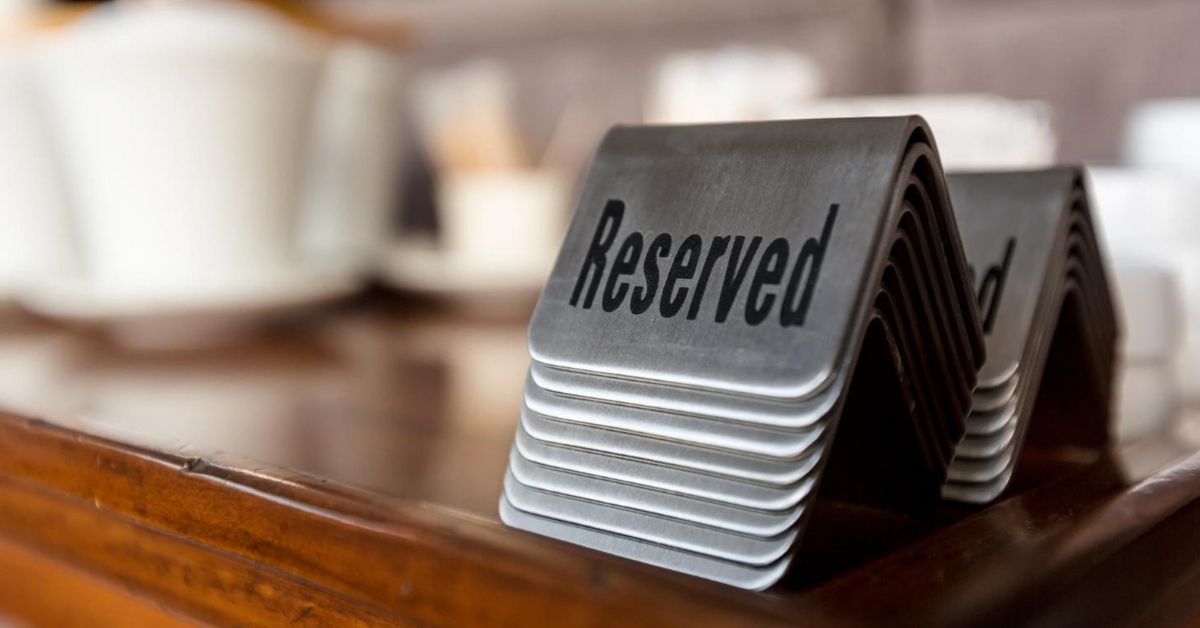Restaurant dining has changed dramatically since its early days. What once was a simple matter of finding an empty seat has evolved into sophisticated systems that balance customer satisfaction with business needs. At the heart of this evolution lies reserved seating – a practice that transforms both guest experiences and restaurant operations. From the elegant reserved sign marking a special table to sophisticated digital booking platforms, these systems create a structure that benefits everyone involved.
Why Restaurants and Diners Love Reserved Seating
Smart restaurant owners know that reserved seating does more than just organize their floor plan. It creates predictable business patterns while giving diners peace of mind.
For Restaurant Owners:
- Financial stability: Knowing how many guests to expect helps with inventory and staffing
- Kitchen preparation: Chefs can prep more efficiently when they know the night’s flow
- Resource management: Staff schedules match reservation patterns, reducing waste
- Customer data collection: Each reservation provides valuable marketing insights
“My reservation system lets me forecast nightly revenue within 15% accuracy,” notes a Seattle restaurant owner. “This precision is crucial during slow seasons.”
For Diners:
- Guaranteed tables for special occasions
- No frustrating wait times
- Personalized service
- Special request accommodation
Most diners will pay more for certainty – restaurants with reserved seating typically see 15-25% higher checks compared to walk-in customers.
Smart Restaurant Seating Arrangements
The physical layout of dining spaces directly impacts both operations and customer satisfaction. Many restaurants find success with a hybrid approach:
Strategic Zoning
- Premium zones: Window seats and quiet corners reserved exclusively for bookings
- Flex areas: Tables that shift between reservations and walk-ins based on demand
- Social spaces: Bar-adjacent seating kept open for spontaneous visitors
Small tables positioned near the kitchen might work perfectly for quick-turnover lunch service, while the same space could transform for intimate dinner reservations with simple lighting adjustments.
Table Mix Considerations
Your restaurant seating arrangement should reflect your typical customer groups:
- Couples (two-tops)
- Families (four-tops and flexible combinations)
- Business meetings (semi-private spaces)
- Solo diners (bar or communal options)
The most flexible restaurants maintain modular furniture that adapts to changing reservation needs, especially for accommodating larger parties that spend more per person.

Creating a VIP Dining Experience Through Reservations
Today’s VIP dining experience isn’t just for celebrities. Smart restaurants treat every reservation as an opportunity to deliver something special.
Recognition Matters
When guests make table reservations, they’re choosing your restaurant over countless others. Acknowledge this choice:
- Use names during greeting (“Welcome back, Ms. Johnson”)
- Note and remember preferences
- Assign consistent servers to returning guests
- Acknowledge special occasions subtly
These small touches cost nothing but dramatically boost loyalty and reviews.
Special Occasion Magic
For milestone celebrations, thoughtful seating makes all the difference:
- Tables with enough space for gifts or champagne
- Appropriate privacy for intimate conversations
- Good lighting for photos
- Distance from high-traffic areas
Some restaurants create designated “celebration zones” where special tables cluster, allowing staff to provide focused attention efficiently.
Beyond Basic Table Reservations
For guests seeking extraordinary moments, consider offering premium booking options:
- Chef’s table experiences
- Wine cellar dining
- Kitchen counter seating
- Private dining spaces
These exclusive reservations command higher minimum spending while satisfying the desire for unique experiences. A New York bistro increased profitability by 22% after introducing tiered reservation options, with their chef’s table consistently booked three months in advance.
The Nuts and Bolts of Table Reservations
Running an effective reservation system means balancing customer convenience with operational needs.
Multiple Booking Channels
Today’s diners expect options:
- Direct website bookings (fee-free for restaurants)
- Reservation platforms (OpenTable, Resy)
- Phone reservations (still essential for personal service)
- Social media booking widgets
The goal? A unified system preventing double bookings while meeting customer preferences.
Preventing No-Shows
Empty tables kill profits. Thoughtful deposit policies protect your business:
- Credit card holds with fair cancellation windows
- Tiered deposits based on party size
- Full prepayment for premium experiences
- Flexible rescheduling options
A Chicago restaurant reduced no-shows from 12% to under 3% by implementing a simple $20-per-person hold policy that converts to a food and beverage credit upon arrival.
Smart Timing Strategies
How you schedule reservations directly impacts turnover and revenue:
- Stagger arrival times to prevent kitchen bottlenecks
- Set realistic duration estimates based on your menu
- Include buffer periods between bookings
- Limit peak-time reservations to maintain flexibility
A Portland bistro increased nightly covers by 18% simply by shifting their reservation slots from on-the-hour to 15-minute intervals, reducing service backup.
The Human Touch: Implementing Reserved Seating
Even perfect systems need people to execute them well.
Staff Training
Your team makes or breaks the reservation experience:
- Software proficiency
- Communication protocols
- VIP and special occasion handling
- Problem-solving skills
Restaurants with weekly reservation role-play training report 40% fewer seating complaints.
Clear Reserved Signs
Physical signs serve multiple functions:
- Confirm to arriving guests their table is ready
- Prevent other customers from claiming reserved spaces
- Create subtle status signals
- Provide practical information
Your reserved sign design should match your restaurant’s aesthetic while clearly communicating its purpose. Some restaurants use digital displays that can be updated remotely when reservations change.
Walk-In Balance
Few restaurants thrive on reservations alone:
- Hold a strategic percentage for spontaneous guests
- Create realistic wait time estimates
- Develop clear communication systems
- Train hosts to explain policies gracefully
The sweet spot varies by restaurant type, location, and day of week – tracking data helps find your ideal balance.

Real Success Stories
The Neighborhood Gem
A 40-seat bistro struggling with empty weeknight tables implemented:
- 75% reserved tables, 25% for walk-ins
- “Date Night Wednesday” promotions for bookings
- Simple text-message reservation system
Result: Weeknight covers jumped 35%, with 22% higher check averages from reserved guests.
The Fine Dining Destination
An upscale spot with sold-out weekends restructured:
- Dynamic deposits based on demand
- Premium pricing for peak slots
- Automated waitlist that filled cancellations
Result: No-shows plummeted from 8% to under 2%, while average checks grew 15% during premium slots.
Looking Ahead: Future Trends in Restaurant Seating
The evolution of reserved seating continues, driven by technology and changing consumer expectations.
AI-Powered Optimization
Artificial intelligence is transforming reservation management through:
- Predictive analytics for optimal table assignments
- Dynamic pricing models based on demand patterns
- Automated communication flows for confirmations and modifications
- Customer preference tracking for personalized experiences
These technologies will make reservation systems simultaneously more efficient and more human-centered.
Experience-Based Reservations
Forward-thinking restaurants are moving beyond simple table reservations to experience bookings:
- Menu journey reservations with paired beverage progressions
- Chef interaction packages added to standard reservations
- Themed seating experiences tied to seasonal concepts
- Multi-sensory dining events with limited availability
This evolution transforms the reservation from a table assignment into an experience commitment, creating new revenue opportunities.
Seamless Integration Across Touchpoints
The future of reservations lies in frictionless systems that connect all aspects of the dining journey:
- Pre-ordering capabilities tied to reservation times
- Integrated payment systems that eliminate end-of-meal transactions
- Preference profiles that follow guests across restaurant groups
- Transportation partnerships that coordinate arrivals and departures
Effective reserved seating represents far more than a scheduling system – it’s a comprehensive approach to restaurant management that enhances every aspect of operations while elevating the guest experience. By implementing thoughtful reservation strategies, restaurants create predictability that benefits both the business and its customers.
The most successful reservation systems strike the perfect balance: they provide structure without rigidity, exclusivity without pretension, and personalization without complication. When executed well, these systems become competitive advantages that distinguish your restaurant in increasingly crowded markets.
As you refine your approach to reserved seating, remember that the ultimate goal extends beyond filling tables. The true objective is to create memorable experiences that turn first-time guests into lifelong patrons. With the strategies outlined in this guide, you’re well-equipped to transform your restaurant’s reservation approach into a powerful tool for sustainable success.











